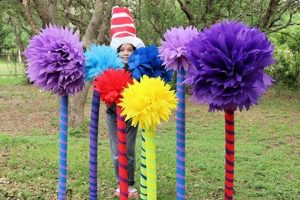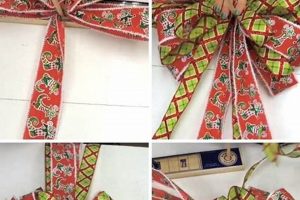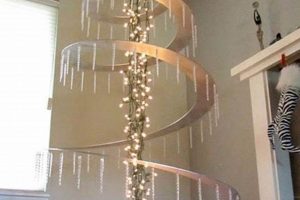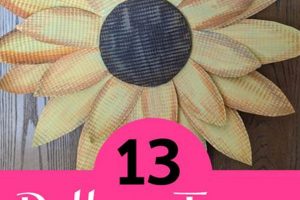A structure designed to hold books, resembling a stylized arboreal form, often constructed by individuals as a do-it-yourself project. This type of shelving unit typically employs shelves arranged to mimic branches extending from a central trunk. A common example is a plywood construction assembled at home using woodworking tools and a pre-designed template.
Such projects offer several advantages, including space optimization, visual appeal, and personalization. Historically, bespoke furniture construction provided an affordable alternative to purchasing mass-produced items. Furthermore, these projects promote resourcefulness and craftsmanship, providing a unique and aesthetically pleasing storage solution.
The following sections will delve into design considerations, material selection, construction techniques, and finishing options applicable to creating a personalized and functional bookshelf of this type.
Essential Considerations for Arboreal Bookshelf Construction
The following guidance provides critical points to consider when undertaking a do-it-yourself bookshelf project inspired by natural tree forms. Adherence to these points will aid in achieving a durable, aesthetically pleasing, and functional result.
Tip 1: Material Selection: Select lumber based on load-bearing capacity and aesthetic preference. Solid hardwoods, such as oak or maple, offer superior strength and longevity. Plywood provides a cost-effective alternative, but requires edge banding for a finished appearance.
Tip 2: Structural Integrity: Prioritize the bookshelf’s stability. Reinforce joints with screws, dowels, or wood glue. Ensure the base is level and capable of supporting the total weight of the books and materials.
Tip 3: Branch Angulation and Depth: Plan shelf placement and angles meticulously. Shallower shelves are suited for smaller paperbacks, while deeper shelves accommodate larger books and decorative objects. Consider the visual balance of the branch arrangement.
Tip 4: Safety Considerations: Sand all surfaces smooth to prevent splinters. Use non-toxic finishes. If mounting to a wall, employ appropriate hardware and locate wall studs for secure attachment.
Tip 5: Template and Measurement Accuracy: Employ a precise template for cutting components. Accurate measurements are essential for proper assembly and alignment of the shelves.
Tip 6: Finishing Application: Apply a consistent and durable finish. Multiple coats of varnish or polyurethane offer protection against moisture and wear. Consider staining to enhance the natural grain of the wood.
Tip 7: Weight Distribution: Distribute the weight of books evenly across the shelves to prevent localized stress and potential structural failure.
Careful planning and execution of these considerations will contribute significantly to the success of the bookshelf construction. Attention to detail at each stage is crucial for achieving a long-lasting and visually appealing result.
The subsequent section will explore common pitfalls and troubleshooting techniques associated with constructing this type of shelving unit.
1. Structural Integrity
Structural integrity is paramount in the context of constructing bookshelves designed to mimic trees. The unique form and branching elements of such designs present distinct engineering challenges compared to conventional shelving. The load-bearing capacity and long-term stability are directly dependent on the integrity of the materials and construction techniques employed.
- Joint Strength and Stability
The joints connecting the shelves (branches) to the central support (trunk) are critical points of stress. Weak joints can lead to shelf sagging, instability, and eventual failure. Techniques such as mortise-and-tenon, dovetail joints, or the use of reinforcing hardware (screws, dowels) are essential for distributing weight effectively and preventing movement at these junctures. For instance, a poorly constructed miter joint, relying solely on glue, will be prone to failure under load, while a properly executed dovetail joint provides significant mechanical interlocking, enhancing the joint’s resistance to shear forces.
- Material Deflection Under Load
The choice of material directly impacts the amount of deflection, or bending, that occurs under load. Softer woods, such as pine, will exhibit greater deflection compared to hardwoods like oak or maple. Plywood, while cost-effective, requires careful consideration of its grade and thickness to ensure adequate stiffness. In real-world applications, excessive deflection can cause books to slide off shelves or create an unsightly sag in the overall structure. Proper material selection and dimensioning are therefore critical for maintaining the aesthetic and functional integrity of the shelf.
- Base Stability and Weight Distribution
The base of the structure must provide a stable foundation capable of supporting the entire weight of the bookshelf and its contents. An unstable base can lead to tipping, particularly if the weight distribution is uneven. Considerations include the size and shape of the base, the use of leveling feet, and the potential for anchoring the bookshelf to a wall. A wide, solid base provides greater stability compared to a narrow, lightweight base. Anchoring to a wall, especially in areas prone to earthquakes or with small children, provides an additional layer of safety.
- Long-Term Creep and Material Degradation
Wood, like all materials, is subject to creep, or slow deformation under sustained load. Over time, the weight of books can cause shelves to sag or joints to loosen. Additionally, wood is susceptible to environmental factors such as moisture and temperature fluctuations, which can lead to warping, cracking, or rot. Applying appropriate finishes (varnishes, sealants) and controlling environmental conditions can help mitigate these effects and prolong the lifespan of the bookshelf. Using kiln-dried lumber minimizes initial moisture content, reducing the risk of warping later on.
The success of a bookshelf project hinges on careful attention to the structural elements. Ignoring these factors can result in a bookshelf that is not only aesthetically unpleasing but also potentially dangerous. A solid understanding of material properties, joint construction, and load-bearing principles is essential for creating a safe, functional, and long-lasting storage solution.
2. Woodworking Skill Level
Woodworking skill level directly dictates the achievable complexity and aesthetic quality of a tree bookshelf project. Inadequate proficiency leads to structural instability, dimensional inaccuracies, and an overall unprofessional finish. Novice woodworkers often face challenges in executing precise cuts, creating strong joints, and applying finishes evenly. Conversely, experienced woodworkers can manipulate materials to achieve intricate designs, incorporating advanced joinery techniques for enhanced durability and visual appeal. For example, a beginner may opt for a simple design using butt joints and screws, while an experienced craftsman could employ mortise-and-tenon joints for superior strength and a seamless aesthetic.
The absence of fundamental skills such as accurate measuring, safe operation of power tools, and proper sanding techniques invariably results in a substandard product. A lack of experience in wood selection can also lead to the use of inappropriate materials that warp, crack, or fail under load. Consider the practical implications: shelves not precisely aligned can cause books to slide off, and poorly sanded surfaces diminish the tactile experience and visual appeal. Advanced skills in carving, shaping, and finishing allow for the creation of bespoke elements that elevate the project from a functional storage unit to a distinctive piece of furniture. Skilled use of woodworking techniques greatly increases structural integrity of the piece as well, increasing its expected lifespan.
In summary, the correlation between woodworking skill level and the success of a tree bookshelf endeavor is undeniable. While simple designs can be executed by beginners with meticulous planning and patience, more elaborate projects necessitate a higher degree of expertise. Recognizing one’s skill limitations and selecting a design accordingly, or investing in woodworking education, are critical steps in achieving a satisfactory outcome. The investment in skill development enhances both the immediate project and future woodworking endeavors.
3. Space Optimization
Space optimization, in the context of constructing a shelving unit resembling a tree, involves maximizing storage capacity within a given area while maintaining aesthetic appeal and accessibility. The design and construction of such a bookshelf must carefully consider the dimensions of the room, the types of items to be stored, and the overall flow of the space.
- Vertical Space Utilization
Traditional bookshelves often occupy significant floor space. A tree-inspired design, however, can effectively utilize vertical space by extending upwards, mimicking the growth pattern of a tree. This configuration allows for increased storage without consuming excessive floor area, a particularly valuable asset in compact living spaces. Examples include extending the “branches” of the shelf to near the ceiling, creating storage opportunities that would otherwise be unused. The implication is a more efficient use of limited square footage.
- Corner Integration
Corners frequently remain underutilized in room layouts. A tree bookshelf can be strategically designed to fit snugly into a corner, transforming an otherwise awkward space into a functional storage area. The “trunk” of the tree can be positioned in the corner, with the “branches” extending outwards along the adjacent walls. This approach not only maximizes storage capacity but also adds a unique visual element to the room’s design. This is important as the shelving can be more easily incorporated into the existing room design.
- Customizable Shelf Depth
Different items require varying shelf depths. A tree bookshelf can be customized to accommodate both small paperbacks and larger hardcovers, as well as decorative objects. By varying the depth of the “branches,” the design can be tailored to the specific needs of the user, optimizing space utilization and preventing wasted space. For instance, shallower shelves can be used for smaller books or picture frames, while deeper shelves can accommodate larger volumes or storage boxes. In the context of book shelves, this may mean the ability to store larger picture books as well as slim paperbacks.
- Multi-Functional Design
Beyond simply storing books, a tree bookshelf can incorporate other space-saving features. For instance, the base of the “trunk” can be designed as a small table or seating area. Alternatively, the “branches” can be configured to accommodate lighting fixtures or hanging plants. By integrating multiple functions into a single structure, the bookshelf becomes a versatile element that contributes to overall space efficiency and also blends together the utility and aesthetic qualities.
The effective implementation of space optimization principles in the construction of a tree bookshelf enhances its functionality and aesthetic appeal. Through careful consideration of vertical space, corner integration, shelf depth customization, and multi-functional design, a seemingly conventional storage unit can be transformed into a space-efficient and visually striking element within the room. The project improves the usability of any room while remaining useful.
4. Design Personalization
Design personalization, in the context of do-it-yourself arboreal shelving projects, encompasses the adaptation of the basic structural framework to reflect individual aesthetic preferences, functional requirements, and spatial constraints. It elevates a standard construction exercise into a unique expression of personal taste and utility.
- Aesthetic Customization
Aesthetic customization permits the incorporation of specific visual elements into the design. This can involve selecting particular wood types based on grain patterns and coloration, applying custom stains or paint finishes, and integrating decorative details such as carved elements or metal accents. For instance, a builder may choose reclaimed barn wood for a rustic appearance or opt for a vibrant color palette to complement existing dcor. The result is a piece of furniture that seamlessly integrates with the surrounding environment while reflecting the owner’s individual style.
- Functional Adaptation
Functional adaptation addresses the specific storage needs of the user. This includes modifying shelf depths and heights to accommodate different book sizes or incorporating specialized compartments for storing media, displaying collectibles, or integrating lighting. For example, adjustable shelves can be implemented to adapt to changing storage requirements, or a dedicated space can be created to house a reading lamp. The project then functions optimally within its assigned space.
- Spatial Integration
Spatial integration involves tailoring the dimensions and configuration of the bookshelf to fit seamlessly within the available space. This may require adjusting the height, width, and depth of the structure to accommodate architectural constraints or maximize storage efficiency. For example, a bookshelf designed for a narrow alcove may feature a slender profile and asymmetrical branch arrangements. This ensures optimal use of available space.
- Material Sourcing and Sustainability
Personalization extends to the ethical considerations of material selection. Individuals may choose to utilize reclaimed lumber, sustainably harvested wood, or eco-friendly finishes to minimize the environmental impact of their project. The selection of non-toxic finishes to maintain the environmental standards. This aligns the project with personal values and contributes to a more sustainable construction process. For example, this may involves using wood certified by the Forest Stewardship Council (FSC) or finishes with low volatile organic compounds (VOCs).
These facets of design personalization underscore the potential for this type of project to transcend mere functionality, becoming an individualized and meaningful addition to the living space. The ability to tailor the aesthetic, functional, spatial, and ethical aspects of the project empowers individuals to create a truly unique and personally relevant piece of furniture.
5. Cost-effectiveness
The economic advantages inherent in constructing a tree-shaped bookshelf through do-it-yourself methods are multifaceted. The initial investment, primarily encompassing raw materials, frequently proves less expensive than purchasing pre-fabricated shelving units of comparable size and aesthetic design. Furthermore, the DIY approach allows for granular control over material selection, enabling the maker to opt for more economical lumber options or to repurpose salvaged wood, thereby reducing the overall expenditure. The economic implications are particularly salient for individuals or families operating within constrained budgetary parameters. Pre-made bookshelves often command a premium due to manufacturing costs and retail markup. The DIY approach, therefore, presents a tangible avenue for cost reduction without necessarily compromising on the functional or aesthetic attributes of the final product. The cost-effectiveness is closely related to available budget to work on a bookshelf.
A further contributor to the cost-effectiveness is the elimination of labor costs associated with professional furniture construction. By assuming the role of both designer and craftsman, the individual circumvents the need to compensate external parties for their time and expertise. This is not to diminish the value of skilled labor, but rather to emphasize the economic advantage accruing to those who possess, or are willing to acquire, the requisite woodworking skills. The required tools, while representing an initial investment, can be utilized across multiple projects, amplifying their long-term value. Consider, for instance, the difference between purchasing a mass-produced bookcase for $300 versus constructing a custom-designed tree bookshelf for $150 using reclaimed wood and existing tools. The savings are considerable and directly contribute to household financial well-being. Furthermore, this allows money to be reallocated to other projects.
However, it is crucial to acknowledge that the purported cost-effectiveness of DIY projects is contingent upon several factors. Errors in construction, resulting in material wastage, can negate potential savings. Furthermore, the time investment required for design, construction, and finishing should not be overlooked; time, for many, represents a valuable resource with an associated opportunity cost. Despite these caveats, a carefully planned and executed tree bookshelf DIY project frequently presents a compelling economic alternative to purchasing commercially available furniture, fostering both financial prudence and creative expression. Thus, budget restrictions can be easily overcome with time and elbow grease.
Frequently Asked Questions
The following questions address common concerns and provide concise information pertaining to the construction of arboreal-themed bookshelves.
Question 1: What are the primary structural considerations for a tree bookshelf?
The design must account for weight distribution, joint strength, and base stability. Reinforcement techniques and appropriate material selection are critical for preventing sagging or collapse.
Question 2: Which wood types are best suited for a durable and aesthetically pleasing tree bookshelf?
Hardwoods such as oak, maple, or cherry offer superior strength and visual appeal. Plywood may serve as a cost-effective alternative, provided that it is of sufficient thickness and properly edge-banded.
Question 3: How does one ensure the stability of a tree bookshelf, particularly with uneven weight distribution?
A wide, solid base is essential. Anchoring the bookshelf to a wall, particularly in homes with children or in earthquake-prone regions, provides an additional safety measure. Leveling feet can compensate for uneven flooring.
Question 4: What are the potential challenges encountered during the construction of a tree bookshelf, and how can they be mitigated?
Common challenges include inaccurate cuts, weak joints, and uneven finishes. Meticulous measurement, precise cutting techniques, and the use of jigs can minimize errors. Proper sanding and the application of multiple coats of finish are essential for a professional appearance.
Question 5: Can existing woodworking skills be adapted to the construction of a tree bookshelf?
Yes, fundamental woodworking skills such as measuring, cutting, joining, and finishing are directly applicable. Familiarity with basic power tools and hand tools is also beneficial.
Question 6: What are some ways to personalize a tree bookshelf design?
Personalization can be achieved through custom paint or stain colors, unique branch arrangements, the incorporation of decorative elements, and the selection of specific wood types with distinct grain patterns.
Effective planning and diligent execution are paramount for successfully constructing a functional and aesthetically pleasing tree bookshelf.
The subsequent section will provide concluding remarks and highlight potential areas for further exploration.
Conclusion
The preceding exploration has elucidated the multifaceted aspects of undertaking a do-it-yourself arboreal shelving project. Structural integrity, woodworking skill, spatial considerations, personalization options, and cost-effectiveness have been identified as key determinants influencing the success and overall value of a bookshelf project inspired by nature. By carefully considering these elements, individuals can create a functional and aesthetically pleasing storage solution.
The construction of a tree bookshelf represents a convergence of practical utility and creative expression. Further investigation into advanced joinery techniques, sustainable material sourcing, and innovative design methodologies may yield enhanced results. The pursuit of craftsmanship in this area promises both functional and aesthetic rewards, contributing to the enrichment of living spaces and the promotion of individual creativity.







